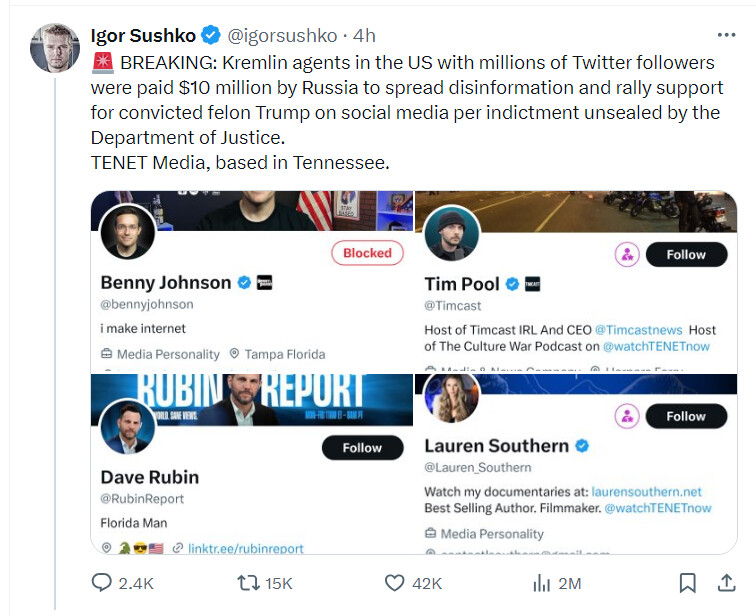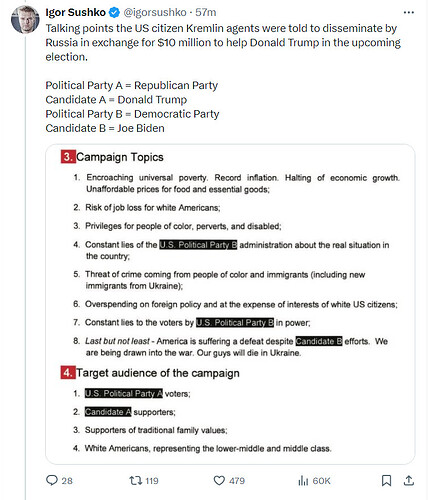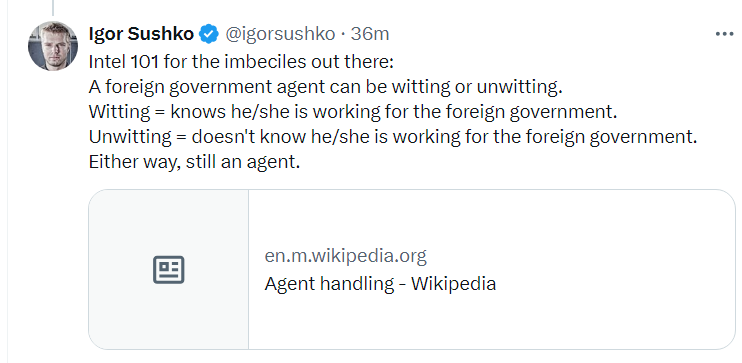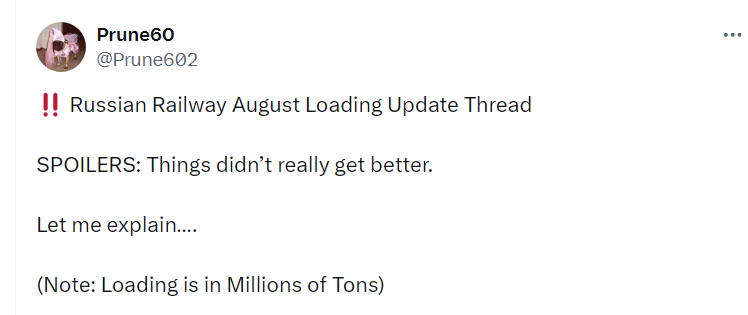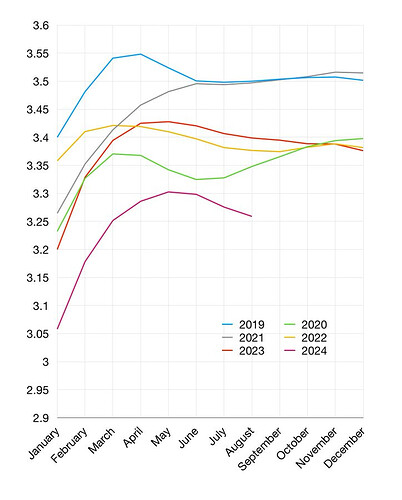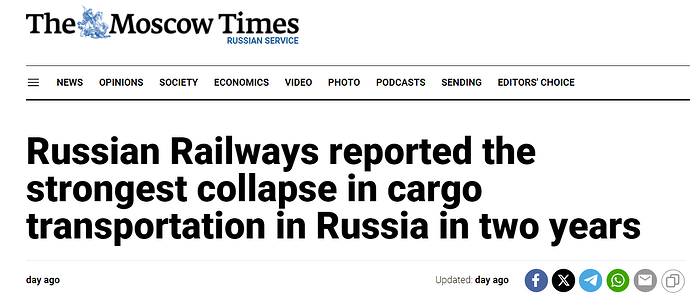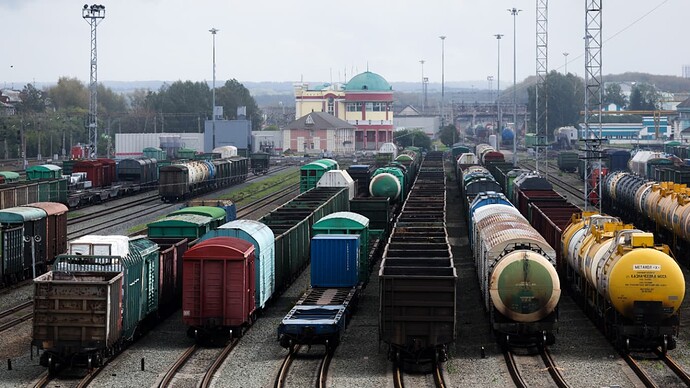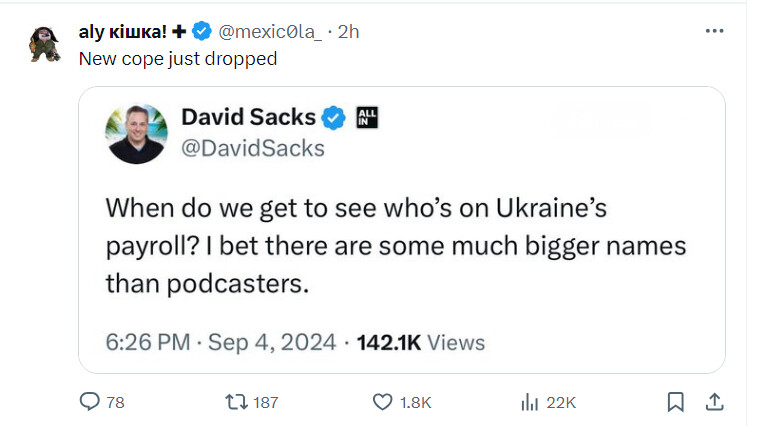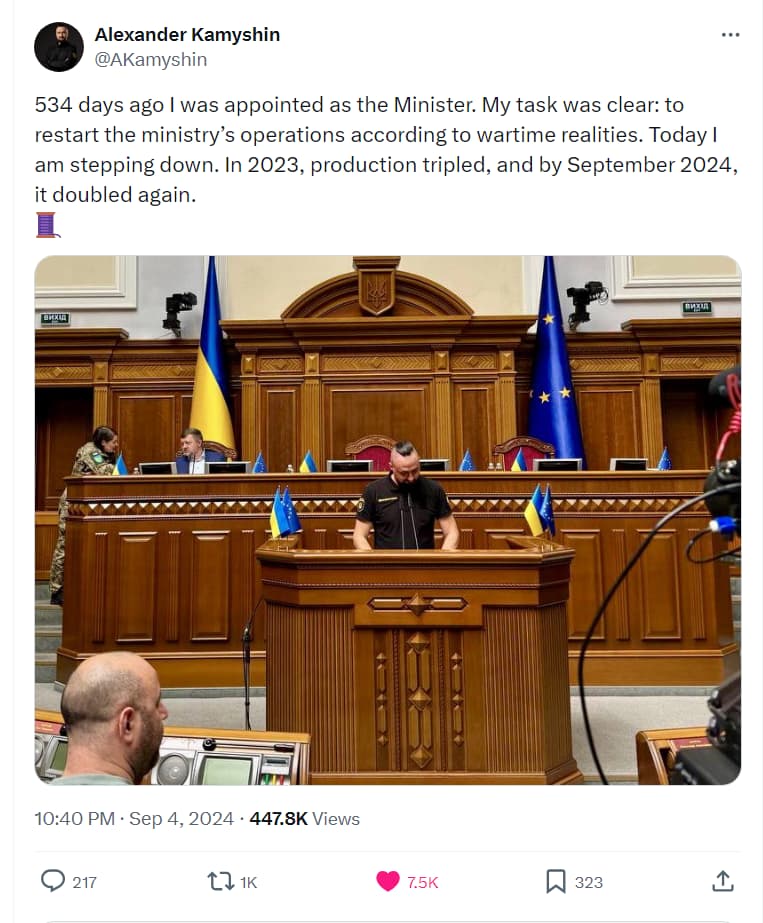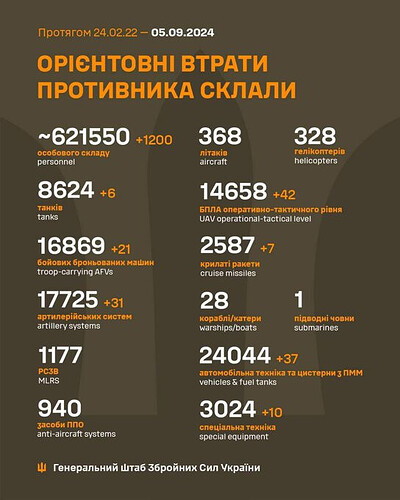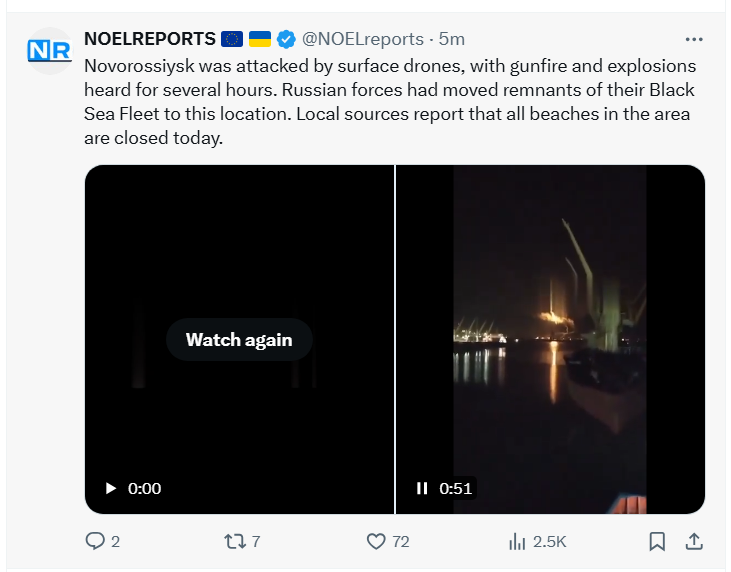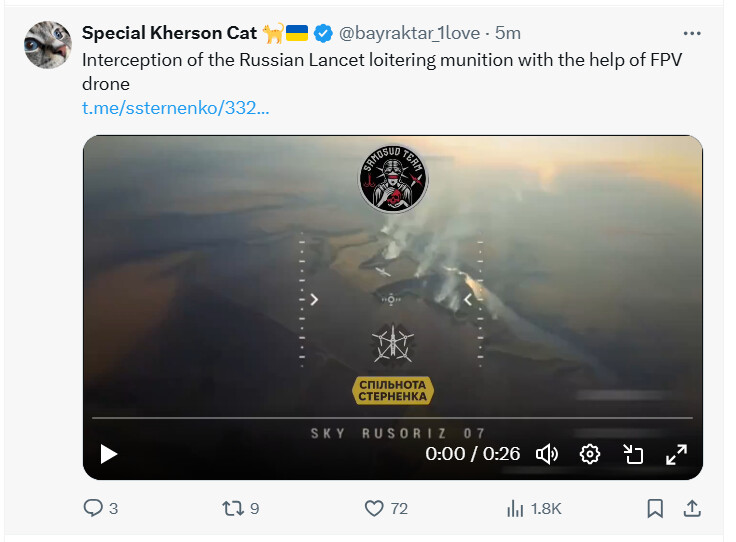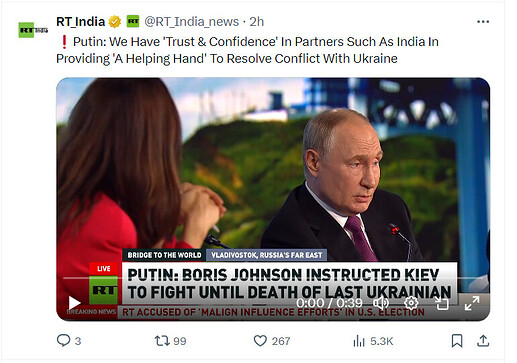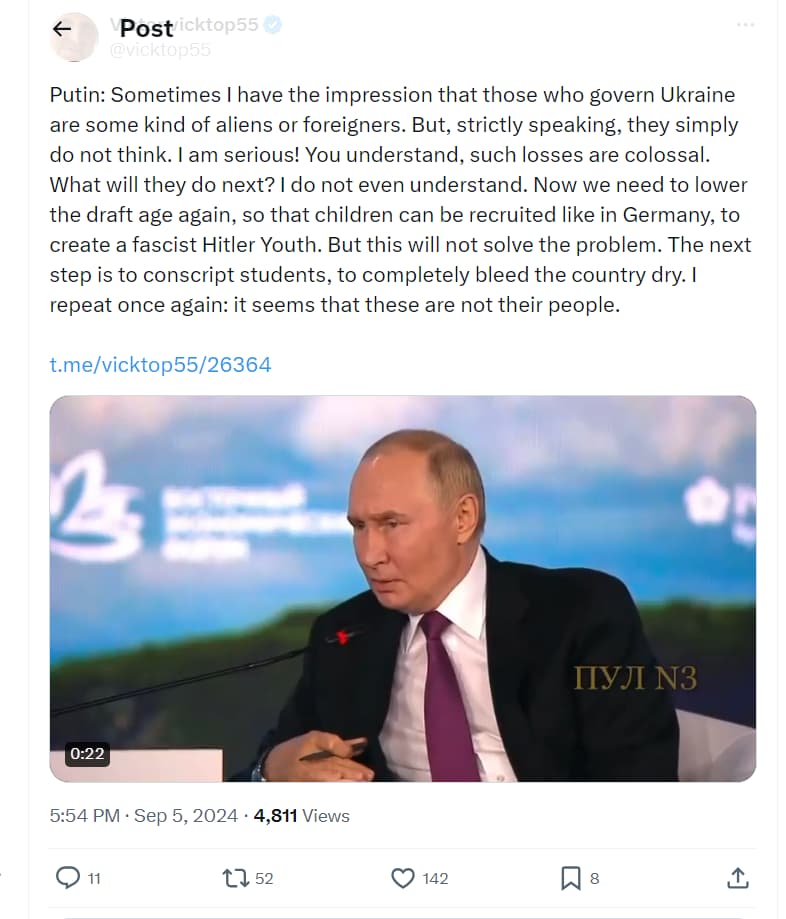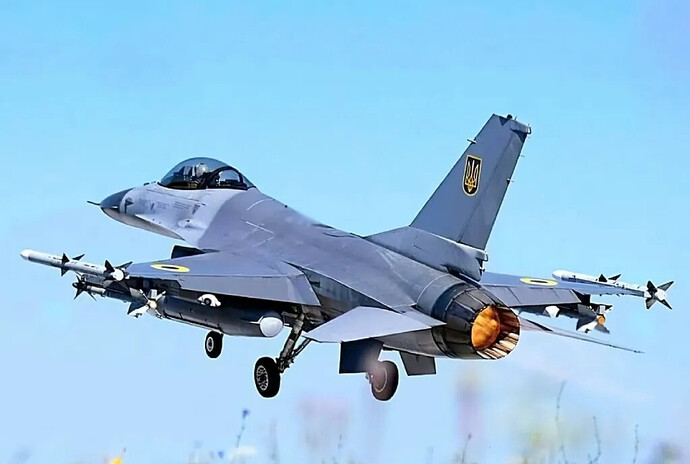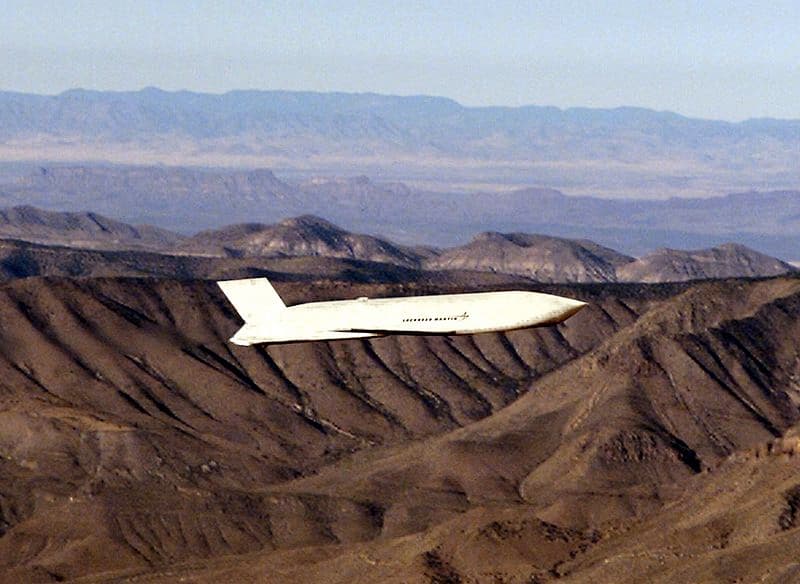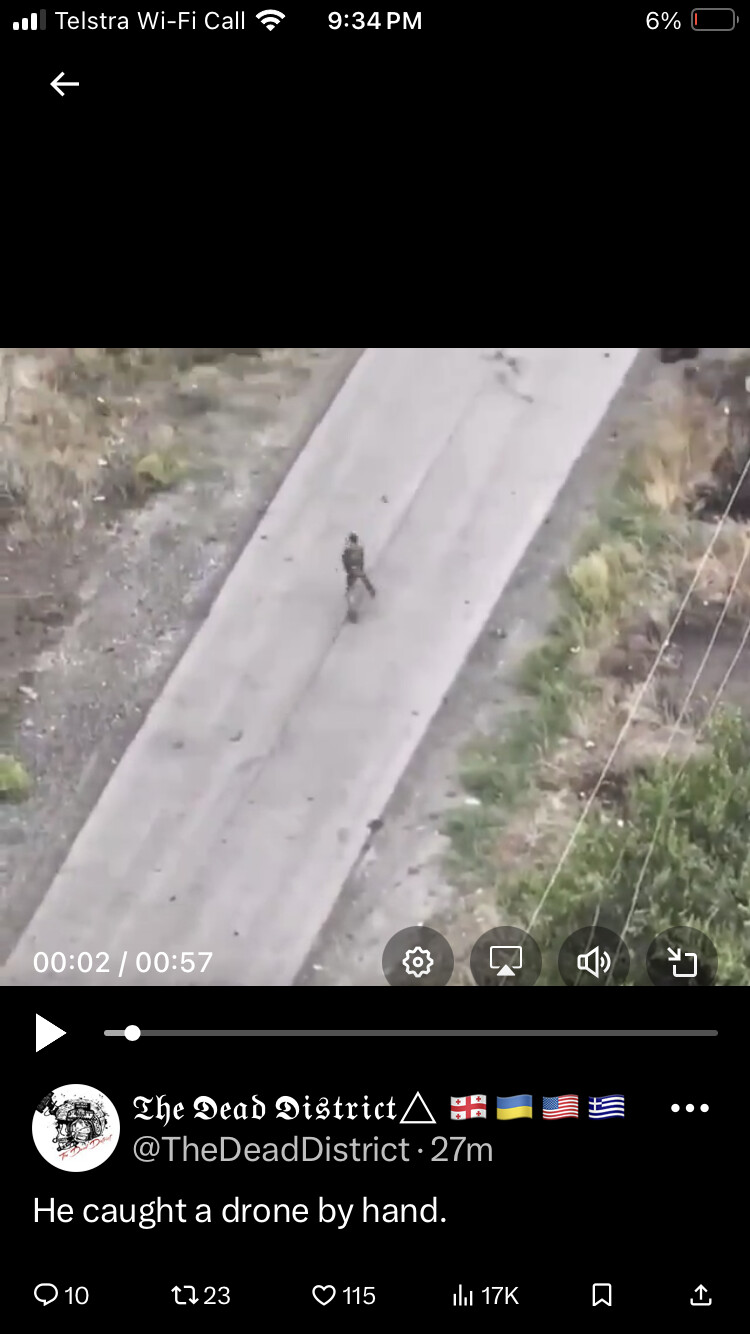Always thought Tim Pool was a useful tool
Russian railways are facing a landslide drop in cargo transportation in Russia, according to Russian Railways statistics.
In August, the transport monopoly, which operates the third largest railway network in the world, transported 97.5 million tons of cargo on freight trains. In annual terms, transportation decreased by 6% - a record since June 2022, and compared to the spring, the decline accelerated threefold: in May it was 2.1%, in June 3%, in July 5.6%.
If the situation does not improve by the end of the year, the collapse of cargo transportation will be the deepest since the global financial crisis of 2008-09, MMI analysts note: “Even during covid, loading fell less.”
The main reason is problems with sales of coal and metals abroad due to falling demand in China and sanctions, MMI emphasizes.
According to Russian Railways, in January-August, the transportation of ferrous metals fell by 7.4%, iron ore - by 3.8%, ferrous scrap - by 14.2%, and non-ferrous ore - by 8.6%. Coal loading sank by 5.7% following a drop in sea exports by 11.4%.
Of the 15 types of cargo that Russian Railways tracks in its statistics, 10 were in the red by the end of August. Transportation of construction materials collapsed by 13.8%, cement - by 4.4%, chemicals and soda - by 3%. After a series of accidents at oil refineries, which have been attacked by drones at least 40 times since the beginning of the year, the transportation of petroleum products sank by 0.6%.
In addition to the drop in exports, Russian Railways are experiencing increasing difficulties with locomotives, MMI points out: last year, due to breakdowns of rolling stock, 42.6 thousand trains were left without movement - twice as many as in 2022.
Cargo transportation is declining as the Russian economy, which has been put on a war footing, slows down. According to Rosstat, the growth rate of industry in July slowed to 3.3% after 4.4% in the first half of the year, and in monthly terms, output volumes have been declining for the second month in a row: in July by 0.8% compared to June, and in June by 1.5% compared to May.
The industrial sector is sensitive to high rates and sanctions, says investment banker Yevgeny Kogan. In the second half of the year, the economy will slow down due to the tight policy of the Central Bank, labor shortages and deteriorating terms of foreign trade, including due to new US sanctions, warns Olga Belenkaya, head of the macroeconomic analysis department of FG Finam.
According to the forecasts of the Central Bank of the Russian Federation, next year the growth rate of Russian GDP may slow down to 0.5-1%, and the growth of investment and consumption may zero out.
Putin, master strategist, continues fueling the US Military-Industrial complex and supporting the US economy…
On a daily basis during my time in command of Army forces in Europe, every day the intelligence “black book” would provide more information on Putin’s Russia attempts at malign influence against the west…and especially against the US.
Today, the @TheJusticeDept has taken action…but because of current divisions in the US, many Americans will have questions.
So let’s talk about it…
Gee, that’s an interesting one.
There has been a lot of hype around Kamyshin.
Russian losses per 05/09/24 reported by the Ukrainian general staff
+1200 men
+6 tanks
+21 AFVs
+31 artillery pieces
+42 UAVs
+7 cruise missiles
I read the first sentence of your post @barry_day and thought gee, no wonder this bloke knows his stuff. He was the big cheese of the army in Europe ![]() . Then I got to the bottom.
. Then I got to the bottom.
Hey, but you still know your stuff.
From what l have been able to ascertain from this thread over the last couple of years, RU leads UA in a couple of key areas.
- Propaganda. RU can do one thing and fail, but their spin doctors have the populace believing otherwise. They are backed up by draconian measures, to it is not only wiser to believe The Kremlin, it is also safer. It appears that little is done on the UA and allies side to dispel any of these elaborate RU fairy stories, so they are allowed to spread.
- RU has been infiltrating the US for years, this is well known, but not much has been done to either shut down their operations, or call them out, until recently.
Not just Russia. Right wing groups world wide, especially in Europe.
Drones will soon be deploying chaff.
It was amazing to me that the NFP emerged and became the force to defeat Le Pen after the results of the first round of the French elections. In calling the elections, Macron was relying on his Centrists and Conservatives. That didn’t work the way he thought it would, with some of the Conservatives moving further right to align with Le Pen.
You couldn’t make this ■■■■ up. What a ■■■■■■■. Putin says he is ready for talks, calls Ukraine recalcitrant. What talks can there be with an invading murderer? Get the ■■■■ out of Ukraine…
Ukraine will give you colossal losses you ■■■■
Confirmation of a Blitz opinion that The West are hamstringing Ukraine and going at it half arsed.
Opinion: Downing missiles while leaving launchers intact is like swatting mosquitos without closing the window
The greatest risk facing Ukraine and the West today isn’t the nuclear war predicted by headlines. Instead, the real dangers are Ukraine’s humanitarian crisis, the influx of refugees, the spread of nuclear weapons, the risk of a larger European war, state-sponsored terror, and disinformation. Most concerning is the potential collapse of trust in America and its allies – a trust that is eroding as we retreat from ineffective threats.
Our fear of unlikely outcomes is allowing genuine perils to fester. This fear, disguised as prudence, feeds the very risks we aim to avoid. Consider current U.S. policy: protecting Russian launch facilities under the belief that it prevents escalation. In reality, this policy restrains Ukraine while Russia attacks at will. Rather than preventing conflict, it prolongs it and risks undermining the global stability we seek to protect.
On Aug. 26, Russia launched the largest missile and drone attacks on Ukrainian infrastructure of the entire war. With 127 cruise missiles and 109 Shahed drones targeting 15 of Ukraine’s 24 regions, Ukraine intercepted most, but many still hit vital infrastructure and population centers.
The Kyiv Hydroelectric Power Plant and energy grids nationwide are not just targets; they are Ukraine’s lifelines. Each hit plunges millions into darkness, worsening their suffering. While Ukraine shows extraordinary resolve, the West remains paralyzed by outdated doctrine that no longer protects us – only Russia. This paralysis not only prolongs the conflict but also weakens global norms against aggression.
Considering this, it’s critical to recognize Russian President Vladimir Putin’s diminishing approval ratings at home. The Ukrainian incursion into Kursk has not only claimed over 1,000 square kilometers of Russian territory but has also left many Russians feeling abandoned by their own government. It’s time to press our advantage. Putin is weakened and vulnerable – an opportunity we must not squander.
Yet, we’ve done nothing but limit Ukraine’s capacity to fight back, prolonging this war. For every missile Ukraine intercepts, Russia launches dozens more. As Ukraine repairs one power grid, Russia destroys another. Over 200 military targets within Russia are within range of U.S.-provided ATACMS missiles, but U.S. policy prohibits Ukraine from striking these key installations.
As six former generals, ambassadors, and cabinet deputies stated in an Aug. 16 letter to U.S President Joe Biden, “Victory means taking out the archer, not defending indefinitely against his arrows.” Former Secretary of State Mike Pompeo echoed these sentiments, criticizing the White House for “consistently setting red lines for our Ukrainian ally” and for having “restricted weapons deliveries out of fear of Putin. But for this weakness, the war could have ended by now.”
It’s far cheaper to destroy launchers than to keep intercepting missiles and rebuilding infrastructure. Shooting down missiles while leaving launchers intact is like swatting mosquitos without closing the window. You might kill a few, but the swarm will keep coming. The proper solution is to close the window – cut off the source – so you’re not endlessly responding to a problem you could have easily prevented. Closing that window means eliminating Russia’s launch sites before more destruction rains down.
We’re investing heavily in expensive defenses while preventing these attacks at their source would be far less costly – not to mention the priceless lives saved by every missile that never hits a hospital or school. The strategy of catching up to Russia’s next move, rather than preempting it, has been a costly failure with far-reaching consequences beyond Ukraine’s borders. Each failure to act now increases the risk of future conflicts.
Meanwhile, Russia celebrates every missile salvo as a victory. Its pundits cheer every strike, calling for more devastation. Every time we prevent Ukraine from retaliating, we further encourage Moscow. The Kremlin is gambling that the West will continue to tie Ukraine’s hands while it “stands with them for as long as it takes”—and we need to tilt the odds back in our favor.
While Russia’s missiles are destroying cities, it is also waging a parallel war of state-sponsored terror and disinformation. These tactics are not only destabilizing Ukraine but also part of a broader campaign to undermine the very fabric of Western democracies. Russia’s cyberattacks, disinformation campaigns, and covert actions are creating instability across borders, while the fear of escalation keeps us frozen in inaction. Left unchecked, this erosion of stability will ripple through the international system, weakening the structures that have maintained peace and security for decades.
But for me – and for the thousands of other patriotic Americans who have chosen to live in Ukraine and support both Ukrainian independence and American national security priorities – this isn’t just an abstract debate about risk; it’s concrete and consequential.
We face the immediate consequences of our government’s hesitation – whether it’s another missile barrage that knocks out power to entire cities, another attack that destroys vital infrastructure, or the death of a friend, journalist, medic, or volunteer on the front lines or in an attack on a hotel. Meanwhile, the West looks on with timid reluctance.
Verbal condemnations, no matter how strong, signal that Ukraine’s allies prefer words to action. The correct response to the record-breaking attack last week is to provide Ukraine with all the weapons and equipment that we or our allies will never use (saving us the cost of storing and decommissioning them) and to remove all restrictions on Ukraine’s use of them (except those imposed by the laws of war).
Ukraine has demonstrated its ability to fight and win. It has developed technological and other capabilities that even its allies lack, often exceeding expectations on the battlefield despite limitations that NATO allies would never face, such as insufficient air power. Despite these constraints, Ukraine has innovated and used its resources efficiently and creatively to achieve significant victories.
Of course, some argue that allowing Ukraine to attack Russian territory risks a nuclear confrontation. But this fear misunderstands the dynamics at play. Russia has been threatening nuclear escalation since the war began, but what we’ve seen is that when faced with firm and decisive action, Moscow recalibrates rather than escalates. Putin is rational about preserving his power and knows that any use of nuclear weapons would have catastrophic consequences for Russia itself. Western timidity is more likely to encourage further Russian aggression, as Putin interprets our caution as weakness.
There is also a greater risk that critics of escalation overlook: the danger of nuclear proliferation. If the West allows Russia to win this war through nuclear blackmail, it will set a dangerous precedent. Countries like Iran, North Korea, and China will take note and realize that possessing nuclear weapons gives them a blank check to commit acts of aggression with impunity. Autocrats around the world would learn that nuclear coercion is a powerful tool to achieve their goals. By failing to stand firm against Russia, we risk triggering a domino effect in which more nations pursue nuclear weapons, destabilizing global security for decades. Thus, far from preventing a nuclear catastrophe, our hesitation could lay the groundwork for many future crises. The stakes are clear: inaction now risks a far more dangerous and unstable world in the future.
The recent missile attack on Kyiv should serve as a wake-up call: Russia will only stop when we force them to. The dangers we face—whether humanitarian disasters, nuclear proliferation, or state-sponsored terror—are real and present. The failure to punish Russia for destroying the Nova Kakhovka dam sent a clear signal: Russia can attack the Kyiv Hydroelectric Power Plant without consequence. And when Russian drones violate NATO airspace without penalty, China gets the message that it can do the same over Taiwan. The consequences of our inaction will extend far beyond Ukraine’s borders.
The U.S., EU, and UK have allocated $97.3 billion in military aid to Ukraine, but that represents just 0.086% of their combined GDP annually—pocket change for the future of democracy. But military aid alone is not enough. We need a muscular new strategy, one that acknowledges Ukraine’s need to fully defend itself, including striking targets deep inside Russia. For pennies on the dollar, we can now secure the global order and send our adversaries running. Spend the money now to fully empower Ukraine or risk spending much more—and potentially risking the lives of our own soldiers – later.
Policymakers must recognize that defeating Russia is not only possible but critical to the security and integrity of the global order. Victory in Ukraine isn’t just about winning this war—it’s about securing peace, stability, and confidence in the U.S.-led alliance. We cannot afford to continue to walk past real threats while hiding in the shadows of unlikely disasters. It’s time to act boldly, put aside our fears, and give Ukraine everything it needs to win—lest the risks we ignore today become the crises of tomorrow.
Fantastic… except the 2nd last paragraph puts a dampener on the whole concept.
Ukraine’s F-16-Launched AGM-158 Air-To-Surface Missiles To Make Life Very Difficult For Russians – Expert
According to a Reuters report citing US officials, the United States is nearing an agreement to provide Ukraine with the AGM-158 Joint Air-to-Surface Standoff Missile (JASSM) that could dramatically enhance the strike capabilities of Ukrainian F-16 Fighting Falcons.
The report also disclosed that one key aspect of the potential deal is the US effort to adapt the JASSM for use with Ukraine’s Soviet-era aircraft.
The anticipated announcement regarding the inclusion of JASSMs in the upcoming weapons package is expected to be made this autumn.
However, a final decision has yet to be made. If approved, the delivery of these missiles may be delayed by several months as the US addresses technical issues associated with their integration and operational compatibility.
This news follows reports from earlier this year when Ukrainian officials revealed plans to receive a type of air-launched cruise missile with a range of up to 300 miles for their F-16s.
While the specifics of this missile were not disclosed at the time, the JASSM’s advanced capabilities align with the type of weaponry Ukraine is seeking to enhance its military effectiveness.
Currently, the JASSM is integrated solely into US-designed aircraft, with Poland also utilizing the missile on more modern F-16 variants.
Ukrainian F-16s, which are of the F-16 AM/BM standard and have undergone the Mid-Life Update (MLU) program, will be capable of carrying up to two JASSMs per aircraft.
Although these jets are not yet equipped with JASSM technology, they may be able to adopt the necessary software or hardware updates to use these missiles.
The report, citing a US official, also disclosed efforts to modify the JASSM missile for use with non-Western fighter jets in Ukraine’s inventory, a development that has not been previously reported.
Although the official did not specify which Ukrainian aircraft could be equipped with the missile, it is known that Ukraine operates a range of Soviet-era jets. These include the MiG-29, Su-24, and Su-27.
This adaptation effort is aimed at enhancing the effectiveness of these older aircraft by integrating advanced missile technology.
A Game-Changer for Ukraine?
The potential integration of the AGM-158 Joint Air-to-Surface Standoff Missile (JASSM) into Ukraine’s military aircraft is poised to significantly shift the strategic balance in the ongoing conflict with Russia.
Experts believe that the introduction of JASSMs—known for their stealth and extended range compared to most existing Ukrainian munitions—could force a substantial repositioning of Russian military assets.
These missiles could potentially push Russian staging areas and supply depots hundreds of miles back, altering the conflict’s operational dynamics.
With a range capable of reaching up to 300 kilometers into Russian territory, JASSMs could target critical installations, including at least 30 airbases, some of which have been pivotal in launching Russian attacks.
This would likely complicate Russia’s capacity to sustain its offensive operations and could potentially afford Ukraine a significant strategic advantage.
If deployed from positions near Ukraine’s northern border with Russia, JASSMs could strike targets as far away as the Russian cities of Voronezh and Bryansk.
In southern Ukraine, launching them close to the front lines could enable strikes on crucial airfields or naval facilities in Crimea, thereby extending the reach of Ukrainian forces and impacting Russian logistical and operational capabilities.
The JASSM is equipped with an advanced inertial navigation system (INS) that guides it to its target with precision. Designed to operate effectively in degraded GPS environments—a scenario highly relevant given Russia’s extensive GPS jamming in Ukraine—this missile offers a tactical edge in electronic warfare conditions.
The older version of JASSMs boasts a range of approximately 370 kilometers (230 miles). These missiles, measuring about 4 meters (14 feet) in length, feature a degree of stealth that makes them difficult to detect on radar. They are capable of flying at low altitudes and can be programmed to follow evasive paths to avoid air defenses.
The AGM-158B JASSM-ER variant has the capability to deliver a warhead at distances of up to 575 miles, whereas the longer-range AGM-158B-2 can reach targets up to 1,200 miles away.
Nicholas Drummond, a former British Army infantry officer and defense industry analyst, expressed surprise at the current situation given the ongoing controversy over supplying Ukraine with missiles capable of hitting targets inside Russia.
He said, “The stealthy AGM-158 JASSM has a 575-mile range (not 230 miles) and a 450 kg warhead. The longer-range AGM-158B-2 reaches 1,200 miles and has a 900 kg warhead.”
Drummond noted that while deploying a few hundred of these missiles from Ukraine’s F-16s might not significantly alter the course of the war, “they’ll make life very uncomfortable for anyone on the receiving end.”
While it is unclear which version of the missile the US is considering supplying, opting for the shorter-range model would mitigate strain on US stockpiles while still delivering considerable operational benefits.
Each JASSM is equipped with a substantial 1,000-pound warhead. However, unlike the Storm Shadow and SCALP missiles provided to Kyiv by Britain and France, JASSMs are not specifically designed for penetrating hardened bunkers.
Should the US proceed with supplying JASSMs to Ukraine, a key question would be whether these missiles would be permitted to target locations within Russia’s borders.
This consideration is heightened by recent Ukrainian advances into Russia’s Kursk region, underscoring the complex strategic decisions that lie ahead.
